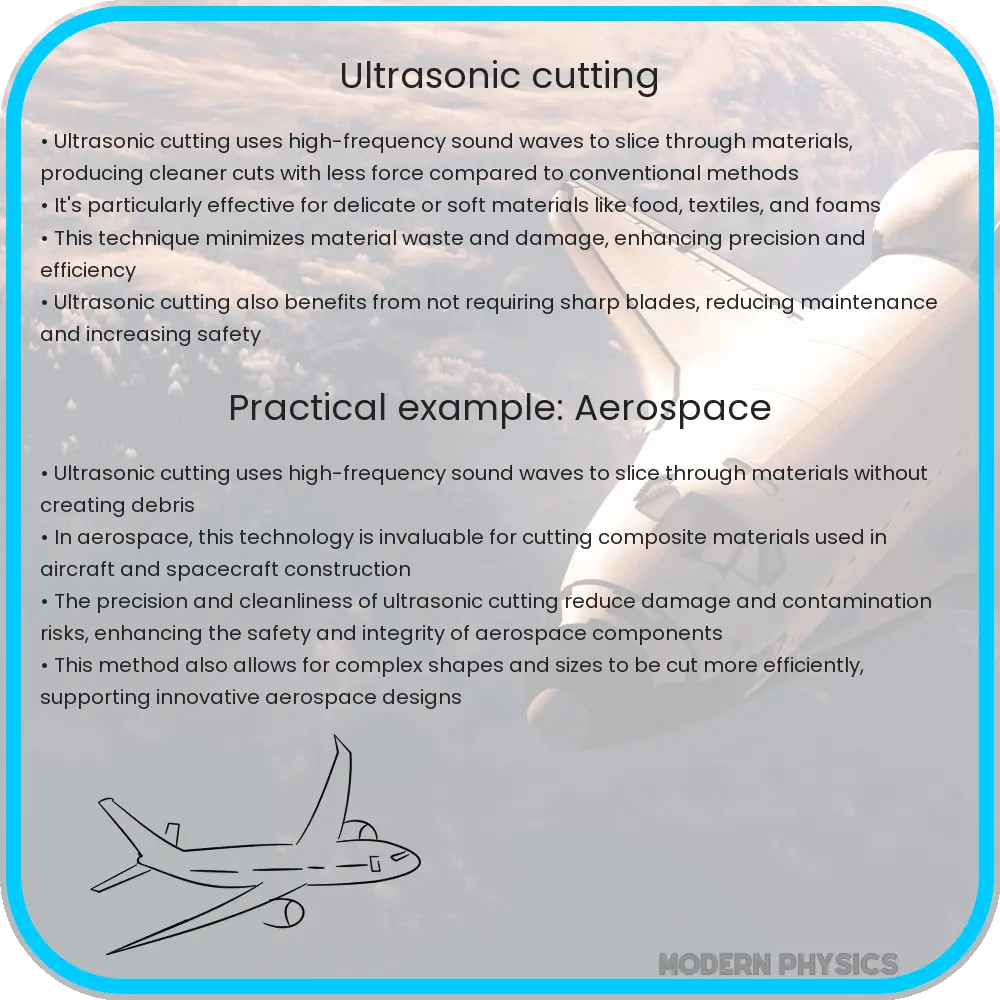Ultrasonic cutting uses high-frequency sound waves for precise, efficient material processing across various industries.

Ultrasonic Cutting: Harnessing Sound Waves for Precision and Efficiency
Ultrasonic cutting is a fascinating application of physics in the field of materials processing, where high-frequency sound waves are used to slice through materials with remarkable precision and speed. This technology leverages the principles of acoustics, specifically ultrasonic waves—sound waves with frequencies above the upper audible limit of human hearing (typically above 20 kHz).
How Ultrasonic Cutting Works
At its core, ultrasonic cutting involves the generation of ultrasonic vibrations using piezoelectric transducers. These transducers convert electrical energy into mechanical vibrations. These vibrations are then transferred to a cutting tool, which is typically a blade or horn configured specifically for the task. The ultrasonic vibrations are amplified and transmitted through the blade, causing it to vibrate at a high frequency and low amplitude.
The mechanism of cutting is primarily attributed to the ultrasonic vibrations causing rapid oscillations of the blade. When applied to a material, these oscillations cause micro-cracks in the material’s structure, facilitating a clean and precise cut. The high-frequency vibrations also reduce the friction between the blade and the material, minimizing wear and tear on the blade and reducing the required force for cutting.
Applications of Ultrasonic Cutting
Ultrasonic cutting technology finds its utility in various industries due to its ability to cut a wide range of materials cleanly and efficiently. Some common applications include:
- Food Industry: Ultrasonic cutting is ideal for foods because it creates clean cuts without deforming or damaging the product. It is particularly useful in cutting soft, crumbly, or layered products like cakes, cheeses, and sandwiches.
- Textile Industry: It provides a non-tactile method to cut fabrics, meaning the fabric does not need to be stabilized or held taut during the cutting process, thus preventing distortion.
- Medical Field: In medical manufacturing, ultrasonic cutting ensures the precision needed for cutting complex shapes out of delicate materials used in the production of items like stents and catheters.
The versatility of ultrasonic cutting extends also to the processing of non-traditional materials:
- Composites: Perfect for cutting composite materials used in aerospace and automotive industries, as it reduces delamination, a common issue with traditional cutting methods.
- Rubber and Plastics: Produces smooth and precise cuts in rubber and various plastics, which are otherwise tough to handle using conventional blade cutting due to material adherence and tearing.
One of the key benefits of ultrasonic cutting is its ability to process materials with little to no thermal damage, maintaining the integrity and properties of the material being cut. This characteristic is paramount in industries where material properties must remain unaltered post-processing.
Advantages of Ultrasonic Cutting Over Conventional Methods
Compared to traditional cutting technologies, ultrasonic cutting offers numerous advantages:
- Precision: The high frequency of blade vibrations allows for extremely precise and minute cuts, which are ideal for intricate designs and patterns.
- Speed: The process is typically faster than conventional methods because it eliminates the need for multiple passes and allows for continuous cutting operations.
- Efficiency: Ultrasonic cutting reduces material wastage and energy consumption. The blades require less frequent replacing due to minimal wear and tear.
Environmental and Safety Considerations
Ultrasonic cutting is not only efficient but also environmentally friendly. Unlike many traditional cutting methods, it does not produce hazardous waste, smoke, or excessive noise. The low power consumption associated with ultrasonic technology also translates into less energy waste, making it a more sustainable option in the realm of material processing.
Safety is another significant aspect of ultrasonic cutting. The technology minimizes the risk of accidents during operation because it uses lower forces compared to mechanical cutting and does not generate high heat, which can lead to burns. Additionally, since the blades are not required to be as sharp as those used in traditional cutting, the risk of injuries from blade contact is substantially reduced.
Challenges in Ultrasonic Cutting
Despite its many benefits, ultrasonic cutting does face some challenges. One of the primary issues is related to the engineering of the ultrasonic generators and blades that must be precisely designed and maintained for effective operation. The initial setup and maintenance costs can be relatively high due to these requirements.
Material properties can also affect the efficiency of ultrasonic cutting. Some materials with high elasticity or extreme hardness may not respond well to the ultrasonic vibrations and can be difficult to cut cleanly. Therefore, ongoing research is dedicated to enhancing the technology to encompass a broader range of materials more effectively.
Future Prospects in Ultrasonic Cutting
The future looks promising for ultrasonic cutting technology with continuous advancements in materials science and ultrasonic equipment. Researchers are exploring new types of composite materials and enhanced piezoelectric materials that could lead to even more efficient cutting processes. There is also a growing trend toward integrating ultrasonic cutting with automated and robotic systems, which would further increase precision, reduce costs, and improve production rates in manufacturing environments.
Moreover, the expansion of this technology into other industries such as electronics, where precision is crucial for cutting micro-sized components, suggests a broadening horizon for ultrasonic cutting applications.
Conclusion
Ultrasonic cutting represents a remarkable fusion of physics and engineering, offering a myriad of advantages over traditional cutting techniques. With its precision, speed, and efficiency, it is revolutionizing various industries, from food processing to aerospace engineering. Despite its challenges, ongoing developments in technology and materials promise to enhance its effectiveness and widen its applicability. Considering its benefits and future potential, ultrasonic cutting is poised to remain a key technology in material processing and manufacturing, driving innovation and sustainability in production practices across the globe.
